Home
Repair And Restoration
How To Repair Stripped Threads
By Stephen "Latchy" Latchford
The cylinder head on the CG 125 I am restoring needed tlc in order to use it for my bike. The three bolts that hold the rocker cover had been stripped by the last owner, but it was by no means scrap. The valves etc. are in good condition and there is a lot of life left in it yet. A bike shop would charge £50 per thread so £150 minimum for this item alone.
This is how I got it to better than new condition by repairing those three threads for a lot less money.
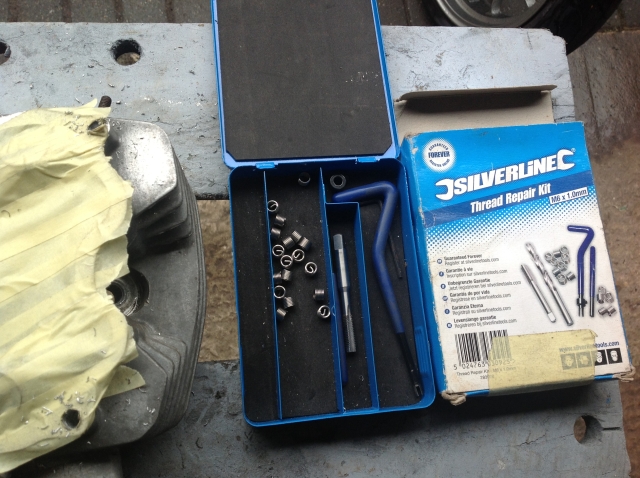
This is the kit you need. It is a 6mm thread repair kit which costs around £20. This one made is made by Silverline. It consists of 1 drill (already in my cordless, sorry) 1 tap, 1 thread driver, several inserts, and finally 1 punch( for removing the tang)
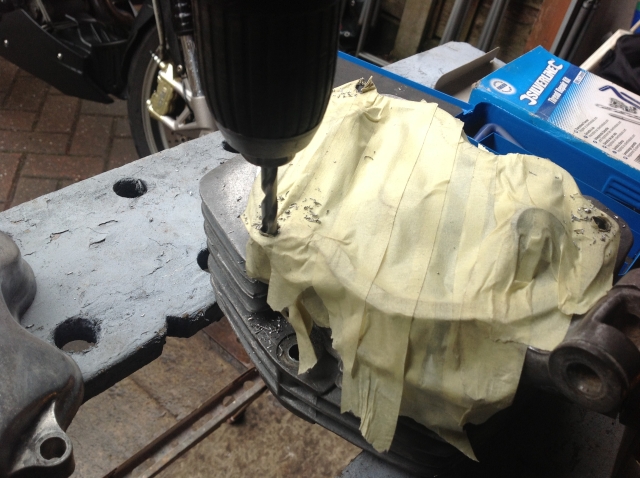
You can see that I have taped over the complete head to protect against metal particles falling in. Be ruthless and just go for it, drill all the old threads out completely with the drill provided.
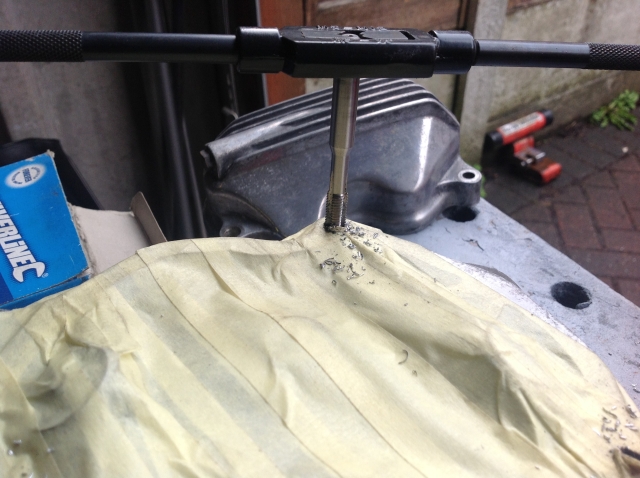
Using a tap handle, or an adjustable spanner, tap out the hole or holes with the tap provided.
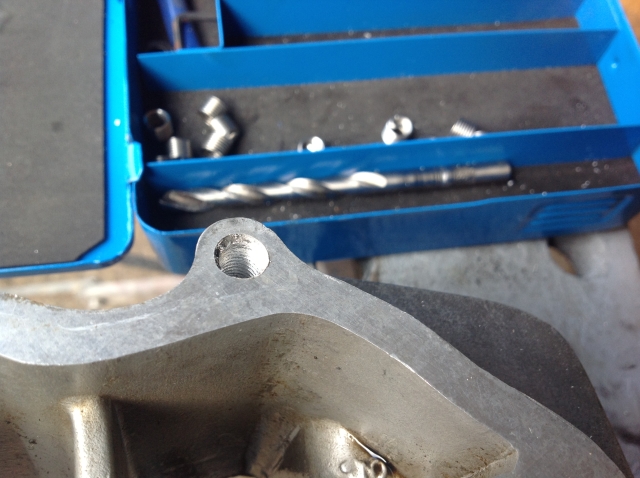
The tapped out hole...
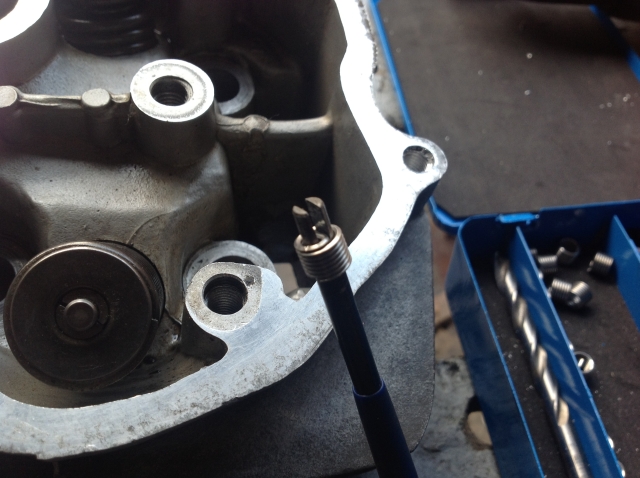
...and the new thread insert on the insertion tool.
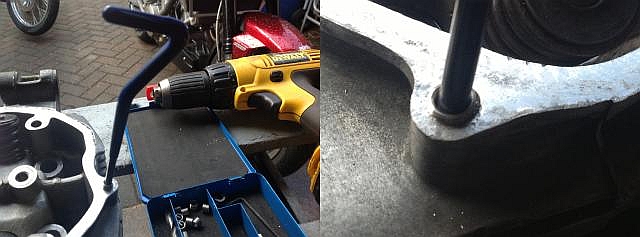
Inserting the thread using the driver provided.
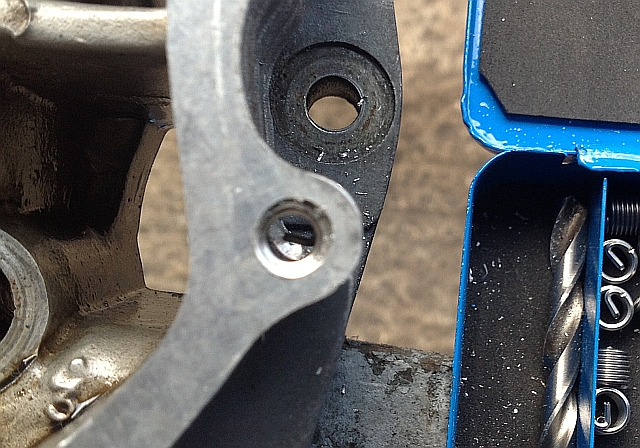
The new thread fully inserted with the small tang of metal still attached, right at the very bottom of the hole.
The tang needs striking with the punch quite firmly in order to snap it off completing the process. Be sure to then tip the tang out.
I really enjoy doing this job, it saves money, recycles valuable motorcycle parts and the new threads are made from stainless steel making them much stronger than the original aluminium threads they replace.
#######################################################################
Many many thanks to Stephen for this nugget of invaluable information. I can tell you it works as he did the same job for me on the exhaust bolts of my CLR 125. I doubted their effectiveness but they have proved more than up to the job.
Cheers Latchy! (Ren - The Ed)
Reader's Comments
Dave Patullo said :-
The Helicoils are a useful method of repairing non critical threads , however there is a better method / system for repairing critical components .
If you Google Wurth Time-sert you will see they do an extensive range of standard and specialist applications.
I have used these on several occasions to repair stripped threads on aluminium brake calliper's as well as a stripped spark plug thread.
https://www.youtube.com/watch?v=anjDQJtWFc8
01/01/2000 00:00:00 UTC
Ren - The Ed said :-
Hi Dave. I've never heard to the Wurth Time-sert before. I know Wurth do some good kit though. Having seen the video it does look a little more substantial than the Helicoil system.
It always looks so simple in the videos though. How easy are they to put in when you're working in tight spots and upside-down? Like real people fixing real bikes end up working.
01/01/2000 00:00:00 UTC
John Watson said :-
I worked as a salesman for Wurth up to about 25 years ago, and TimeSert was on the go then. It is far far easier than helicoil to fit, and far more permanent and I would recommend it to anyone.
The only downside is that it is more expensive than helicoil but that is always the price of top quality gear.
01/01/2000 00:00:00 UTC
Ian Soady said :-
I've always found helicoil (and similar) to be fine, and not difficult at all to fit. The only exception is where the original hole has been damaged to such an extent that the helicoil can't be fitted securely. In these cases I make up a threaded insert of my own. In this case a 7/16" BSW outer thread with a 5/16" Cycle inner.......
Some pics here:
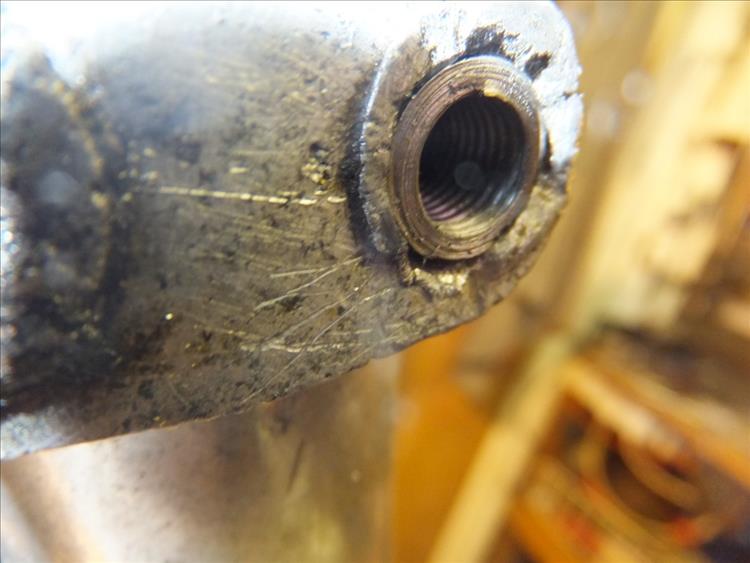 01/01/2000 00:00:00 UTC
01/01/2000 00:00:00 UTC
Ian Soady said :-
Meant to add the photobucket link for all pics. Below I hope.
http://s43.photobucket.com/user/iansoady/library/bike/Matchless/insert?sort=4&page=1
01/01/2000 00:00:00 UTC
Ren - The Ed said :-
John I've had a look online at the Wurth TimeSert and they look quite substantial. Ian, your DIY insert looks like quite a lot of work! I do love the engineering though. And what sort of chap has a lathe? I want a lathe but before I get a lathe I'd need a garage. Before I get a garage I'd need some money. Before I get some money I'd need to work a lot harder. And I don't want to work a lot harder. Hence why I haven't got a lathe. Can I borrow yours?
01/01/2000 00:00:00 UTC
John Watson said :-
Cracking job with the insert, Ian. I believe you can buy similar already made up, Snap-on have a similar system.
TimeSert take up no more room, radially, than a helicoil, that is because of the synchronised thread on the inside and outside of the insert, you can in fact use a TimeSert tap to fit helicoils and vise versa.
The biggest single advantage is TimSerts ability to lock itself into the threaded hole unlike helicoils, which, particularly in high temperature applications can loose their temper and are liable to come out when disassembling again.
Ian, I have used heliciol on a number of occasions in the past and I appreciate that they are not particularly difficult, it's just that I feel timesert has a number of advantages over helicoils, good work on those inserts by the way.
01/01/2000 00:00:00 UTC
Ian Soady said :-
"And what sort of chap has a lathe?" - doesn't everyone? I paid £100 about 20 years ago and it's repaid me many times over.
"Can I borrow yours? " - of course, pop down to Brum any time. None of these new-fangled metric threads of course......
01/01/2000 00:00:00 UTC
Ren - The Ed said :-
Hey Ian - I guess I'll have to bring my own metric taps then huh.
01/01/2000 00:00:00 UTC
Ian Soady said :-
No, it's the 127 tooth change wheel you need!
01/01/2000 00:00:00 UTC
Ren - The Ed said :-
Ian...you've completely lost me there...
01/01/2000 00:00:00 UTC
Ian Soady said :-
As intended.
It's because to cut threads on a lathe you need to drive the lead screw at the correct ratio with the main spindle to get the right pitch. As my antique lathe has an 8 tpi (threads per inch) lead screw you need the 127 tooth change wheel in the gear train between the spindle and the lead screw to get the correct relationship (1 inch = 25.4 mm: 127 is the smallest integer divisible by that......).
Although it has been known for people to cut a 26 tpi thread and bodge it.
Just think how much you're learning!
01/01/2000 00:00:00 UTC
Ren - The Ed said :-
Aaah...so your ratio's are all imperial I get it. Look I just use a rattly old hand drill and some cheap taps I have lying around. There's no professional, accurate and skilled work at my place just bodging.
01/01/2000 00:00:00 UTC
Name
Comment
Add a RELEVANT link (not required)
Upload an image (not required) -
Uploading...
Home
Repair And Restoration